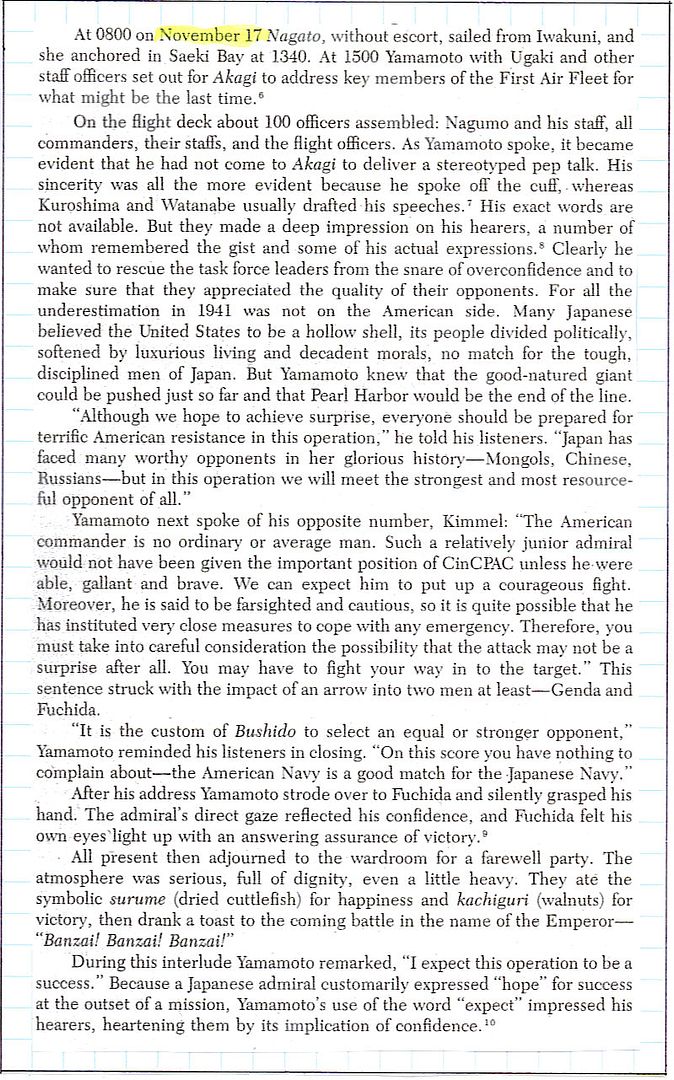
Gordon W. Prange, At Dawn We Slept
(p44) "From mid-November onward, American radio monitors linked Carrier Divisions Three and Four with the Japanese battle force headed for the Southeast Asia region.
Their sortie port was Sasebo on the southwest corner of Kyushu, the most westerly of Japan’s home islands.
Reports issued by the monitor stations were emphatic.
The two light carrier divisions were under the command of Japan’s Third Fleet and were headed for Southeast Asia.
Missing from the southern-movement scenario were the six heavy flattops of Carrier Divisions One, Two, and Five.
They were sailing to Pearl Harbor on Route 2.
Refering to Dutch Naval attache in Washington, Captain Johan Ranneft's diary:
(p46-48)"By reconstructing records of Station H and Japanese naval records, the destination and the departure port for Ranneft’s mystery force is made clear.
Japan’s fleet movement to Hawaii fitted into two time frames in late November: (1) assembly at standby locations on November 17–25, and (2) the sortie to the target November 25–December 7.17
Hitokappu Bay, an inlet on Etorofu Island in the Kurile Islands group, was the assembly location for the six carriers of the First Air Fleet—the offensive power of the Pearl Harbor raid.
Joining the carriers in the anchorage were its support force of two battleships, two heavy cruisers, one light cruiser, eleven destroyers, and three “I” type submarines, plus the crucial supply train of seven tankers.
"Several warships committed a serious radio security breach during their sortie to the Hitokappu Bay anchorage: each transmitted coded movement reports—reports that could be read by American naval cryptographers in Washington, according to Albert Pelletier one of the Navy’s top cryppies at Station US.18
These Japanese warship movement reports are substantiated by intercept records of Station H.
"None of the movement reports were shown to the 1945–46 congressional investigation or to the one in 1995.
Instead, Congress was told that American radio intelligence had “lost” the warships because each Japanese naval vessel maintained radio silence.
Admiral Kimmel’s intelligence chief, Edwin Layton, substantiated this claim.
During his Capitol Hill testimony in 1946, he said neither the Japanese carriers nor the carrier commanders were ever addressed or heard on Nippon radio frequencies in the twenty-five days preceding Pearl Harbor.
"But Layton was covering up.
The radio intercept reports were available, but Layton failed to inform Admiral Kimmel of the Japanese movement to Hitokappu Bay.19
"In fact, Navy radio monitoring stations at Corregidor, Guam, Hawaii, and Dutch Harbor, Alaska, intercepted the transmissions.
Japanese warships and the commanding admirals of the thirty-one-ship Hawaii force broke radio silence and were addressed by Tokyo radio during the twenty-five days from about November 12 through the December 7 “surprise attack.”
"One intercepted message on November 18 defied all security precautions and spelled out H-I-T-O-K-A-P-P-U-B-A-Y.
The Roman letters were not even encoded—they were spelled out in clear.
Confirmation of this is available from the Station H records, but Captain Duane Whitlock, the radio traffic analyst at CAST, denies that such a message was sent.
"Other warships went on the Japanese naval air waves and confirmed that Hitokappu Bay was the standby location for the Hawaii force.
British naval monitors at Singapore and their Dutch counterparts in Java heard the same broadcasts.20
General Hein ter Poorten, commander of the Netherlands army forces in the DEI, said his cryptologists at Kamer 14 had evidence that “showed Japanese naval concentration near the Kuriles.”21
"The plain-language dispatch of the words “Hitokappu Bay,” confirmed a prediction made on the basis of radio intercepts on October 22, 1941, by Joseph Rochefort, the commander of Station HYPO on Oahu, who told Admiral Kimmel that Japan was in the midst of a large-scale screening maneuver or operation involving air units.
Rochefort laid out the operation for Kimmel.22
He predicted it would include a vast triangular area of the Pacific Ocean from the Kurile Islands in the north to the Marshall Islands in the south and Marcus Island in the east and extending to the southeast areas of Asia.
For emphasis, Rochefort cited the Kurile Islands three times in the prediction.
He had discovered Japan’s secret sortie port for Route 2.
Stinnett, Robert (1999-12-14). Day of Deceit -- The Truth about FDR and Pearl Harbor